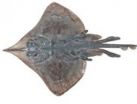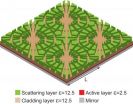(Press-News.org) The University of Hawaii' at Mānoa's Pan-STARRS PS1 telescope on Haleakala has discovered an asteroid that will come within 4 million miles of Earth in mid-October. The object is about 150 feet in diameter and was discovered in images acquired on September 16, when it was about 20 million miles away.
It is the first "potentially hazardous object" (PHO) to be discovered by the Pan-STARRS survey and has been given the designation "2010 ST3."
"Although this particular object won't hit Earth in the immediate future, its discovery shows that Pan-STARRS is now the most sensitive system dedicated to discovering potentially dangerous asteroids," said Dr. Robert Jedicke, a University of Hawaii at Mānoa member of the PS1 Scientific Consortium (PS1SC), who is working on the asteroid data from the telescope. "This object was discovered when it was too far away to be detected by other asteroid surveys," Jedicke noted.
Most of the largest PHOs have already been catalogued, but scientists suspect that there are many more under a mile across that have not yet been discovered. These could cause devastation on a regional scale if they ever hit our planet. Such impacts are estimated to occur once every few thousand years.
Objects the size of 2010 ST3 usually break up in Earth's atmosphere, but the resulting blast wave on the surface can still devastate an area covering hundreds of square miles. "There is a very slight possibility that ST3 will hit Earth in 2098, so it is definitely worth watching," Jedicke said.
Dr. Timothy Spahr, director of the Minor Planet Center (MPC), said, "I congratulate the Pan-STARRS project on this discovery. It is proof that the PS1 telescope, with its Gigapixel Camera and its sophisticated computerized system for detecting moving objects, is capable of finding potentially dangerous objects that no one else has found." The MPC, located in Cambridge, Mass., was established by the International Astronomical Union in 1947 to collect and disseminate positional measurements for asteroids and comets, to confirm their discoveries, and to give them preliminary designations.
Pan-STARRS expects to discover tens of thousands of new asteroids every year with sufficient precision to accurately calculate their orbits around the sun. Any sizable object that looks like it may come close to Earth within the next 50 years or so will be labeled "potentially hazardous" and carefully monitored. NASA experts believe that, given several years warning, it should be possible to organize a space mission to deflect any asteroid that is discovered to be on a collision course with Earth.
Pan-STARRS has broader goals as well. PS1 and its bigger brother, PS4, which will be operational later in this decade, are expected to discover a million or more asteroids in total, as well as more distant targets such as variable stars, supernovas, and mysterious bursts from galaxies across more than half the universe.
The PS1 surveys have been made possible through contributions of the PS1 Science Consortium (www.ps1sc.org): the University of Hawaii at Mānoa Institute for Astronomy; the Pan-STARRS Project Office; the Max-Planck Society and its participating institutes, the Max Planck Institute for Astronomy, Heidelberg and the Max Planck Institute for Extraterrestrial Physics, Garching; the Johns Hopkins University; Durham University; the University of Edinburgh; the Queen's University Belfast; the Harvard-Smithsonian Center for Astrophysics; the Las Cumbres Observatory Global Telescope Network, Inc.; and the National Central University of Taiwan. Construction funding for Pan-STARRS (short for Panoramic Survey Telescope & Rapid Response System) has been provided by the U.S. Air Force Research Laboratory.
INFORMATION:
Founded in 1967, the Institute for Astronomy at the University of Hawaii at Manoa conducts research into galaxies, cosmology, stars, planets, and the sun. Its faculty and staff are also involved in astronomy education, deep space missions, and in the development and management of the observatories on Haleakala and Mauna Kea.
University of Hawaii at Manoa Pan-STARRS discovers first potentially hazardous asteroid
2010-09-28
ELSE PRESS RELEASES FROM THIS DATE:
New oil detection technique
2010-09-28
CSIRO scientists have developed a revolutionary technique for the rapid on-site detection and quantification of petroleum hydrocarbons (commonly derived from crude oil) in soil, silt, sediment, or rock.
Developed in collaboration with waste technology specialist, Ziltek Pty Ltd, the technique means that the presence of petroleum hydrocarbons can now be quantified simply by using a hand-held infrared spectrometer to take readings at the site of interest, without the need to take samples or perform any kind of processing.
The technique could be used for oil exploration ...
Climate change hits southeast Australia fish species
2010-09-28
Scientists are reporting significant changes in the distribution of coastal fish species in south-east Australia which they say are partly due to climate change.
CSIRO's Climate Adaptation and Wealth from Oceans Flagships have identified 43 species, representing about 30 per cent of the inshore fish families occurring in the region, that exhibited shifts thought to be climate-related.
These include warm temperate surf-zone species such as Silver Drummer and Rock Blackfish that are breeding and have become more abundant, and range increases in Snapper and Rock Flathead. ...
Solar cells thinner than wavelengths of light hold huge power potential
2010-09-28
In the smooth, white, bunny-suited clean-room world of silicon wafers and solar cells, it turns out that a little roughness may go a long way, perhaps all the way to making solar power an affordable energy source, say Stanford engineers.
Their research shows that light ricocheting around inside the polymer film of a solar cell behaves differently when the film is ultra thin. A film that's nanoscale-thin and has been roughed up a bit can absorb more than 10 times the energy predicted by conventional theory.
The key to overcoming the theoretical limit lies in keeping ...
A revolutionary new way of reversing certain cancers
2010-09-28
Australian and American scientists have found a way of shrinking tumours in certain cancers – a finding that provides hope for new treatments.
The cancers in question are those caused by a new class of genes known as 'microRNAs', produced by parts of the genome that, until recently, were dismissed as 'junk DNA'. While much is still unknown about microRNAs, it is clear that they can interfere with how our genes are 'read'.
The current finding identifies one particular microRNA (microRNA 380) that appears to disable the king of tumour suppressors, the P53 gene. So important ...
2010 AAO-HNSF miniseminars: Tuesday, Sept. 28, 2010
2010-09-28
Boston, MA – The 2010 Annual Meeting & OTO EXPO of the American Academy of Otolaryngology – Head and Neck Surgery Foundation (AAO-HNSF), the largest meeting of ear, nose, and throat doctors in the world, will convene September 26-29, 2010, in Boston, MA.
Featuring more than 305 scientific research sessions, 594 posters, and several hundred instruction course hours for attendees, the annual meeting is a unique opportunity for journalists from around the world to cover breaking science and medical news. Reporters will have access to the latest research and clinical advances ...
2010 AAO-HNSF new research highlights: Tuesday, Sept. 28, 2010
2010-09-28
PACU PTH Facilitates Safe Outpatient Total Thyroidectomy
Presenters: William Pechter, MS; David Steward, MD; Jeffrey Houlton, MD; Naresh Panda, MS, FRCSEd
Time: 8: 32 am
Location: 254
Boston, MA – A study was performed reviewing thyroidectomies from March 2008 to November 2009, to determine if a serum parathyroid hormone (PTH)-based discharge algorithm can be used to safely facilitate outpatient total thyroidectomy.
In a presentation at the 2010 AAO-HNSF Annual Meeting & OTO EXPO in Boston, researchers revealed that 180 patients (mean age 48.9, 83.3% female) underwent ...
More developing countries show universal access to HIV/AIDS services is possible
2010-09-28
28 September 2010 | GENEVA / NAIROBI / WASHINGTON D.C – Significant progress has been made in several low- and middle-income countries in increasing access to HIV/AIDS services, according to a new report released today. The report Towards Universal Access by the World Health Organization (WHO), the United Nations Children's Fund (UNICEF) and the Joint United Nations Programme on HIV/AIDS (UNAIDS) is the fourth annual report for tracking progress made in achieving the 2010 target of providing universal access to HIV prevention, treatment and care.
The report assessed ...
GOES-13 Satellite sees Lisa a tropical storm ... for now
2010-09-28
The GOES-13 satellite has been keeping an eye on Tropical Storm Lisa and watched her birth, graduation to depression then tropical storm and back to depression. Now, Lisa has grown back to tropical storm status, but it may be short-lived.
At 11 a.m. EDT on Friday, Sept. 24, Tropical Storm Lisa had maximum sustained winds near 50 mph and she may strengthen and weaken over the weekend, but by Sunday colder waters will zap her energy source and she is forecast to be a depression.
Meanwhile, on Sept. 24, she was still frolicking in the eastern Atlantic, about 320 miles ...
Scientists discover gene linked to a common form of migraine
2010-09-28
Montreal, September 26th, 2010 at 1:00 PM – An international study led by scientists at Université de Montréal and University of Oxford, has identified a gene associated with common migraines. Their findings show that a mutation in the KCNK18 gene inhibits the function of a protein called TRESK. TRESK normally plays a key role in nerve cell communication. Published today in Nature Medicine, this study may have implications for people who suffer from recurrent headaches, which include more than six million Canadians.
Previously, genes for migraine have been found only ...
Single electron reader opens path for quantum computing
2010-09-28
A team led by engineers and physicists at the University of New South Wales (UNSW) in Sydney, Australia, have developed one of the key building blocks needed to make a quantum computer using silicon: a "single electron reader". Their work was published today in Nature.
Quantum computers promise exponential increases in processing speed over today's computers through their use of the "spin", or magnetic orientation, of individual electrons to represent data in their calculations.
In order to employ electron spin, the quantum computer needs both a way of changing the ...



